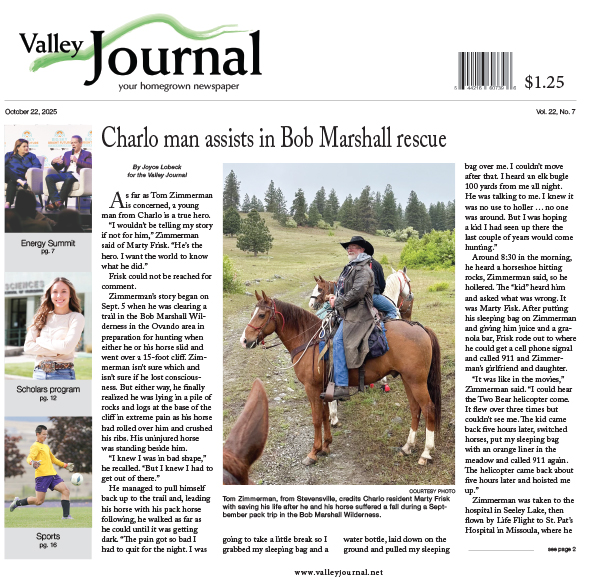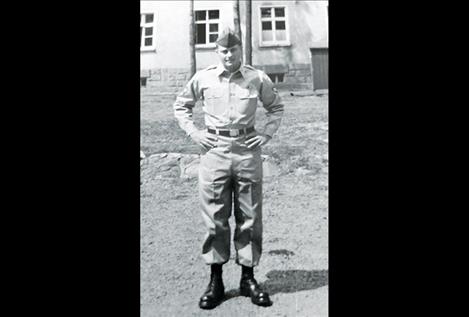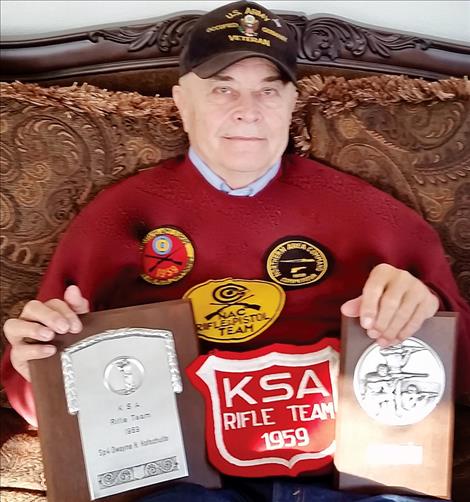Veteran spotlight: Dwayne Hofschulte
Hey savvy news reader! Thanks for choosing local.
You are now reading
3 of 3 free articles.
(Editor’s note: This series of articles honors our Veterans of Foreign Wars (VFW) as they share their military service experiences with the community. This 36th article is about Dwayne Hofschulte.)
February 19, 1938 Cold War - Germany U.S. Army - Sp 4 NORCOM (Northern Area Command of the U.S. Army in Europe)
Dwayne Hofschulte began his military career early by joining the Minnesota Army National Guard in 1954 at age 16 while still in high school in Elgin, Minnesota. The Guard met once a week and two weeks in summer. Members earned $2 for each meeting, which was welcome money to a young man who only got the occasional nickel or dime from Dad. The draft was in effect, so when he graduated in June 1956, he joined the regular military. He thought about the Navy, but it didn’t have the program that guaranteed the school of his choice like the Army had.
On Sept. 21, 1956, after working for his dad on the farm during the summer, the recruiter put Dwayne on the bus to Minneapolis, Minnesota with the guarantee that he would be going to heavy equipment operator school. He completed his physical and that same day was on another bus to Fort Chaffee, Arkansas for processing.
Dwayne then went by train to Fort Carson, Colorado, for eight weeks of basic training. He enjoyed this time. The hiking and calisthenics were no bother for someone who played football and worked on the farm. The trainers, called the “cadre,” were in their 20s and 30s. The whole division, about a few thousand men, had just come back from service in Korea. Training was geared towards survival and was very practical with things like the use of sound and light to estimate distances. Men had to crawl under barbed wire with live fire overhead and lay in foxholes while tanks ran over them – both scary exercises. They also spent many, many days on the rifle range.
With no leave time after basic training, Dwayne took the train to Fort Leonard Wood, Missouri, and reported for eight weeks of crane operator school. They trained on five attachments: shovel front, dragline, clam bucket, pile driver and hook. After three weeks, Dwayne finally got a 2-week leave to go home for Christmas. Back at Fort Leonard Wood, he finished classes. If it rained, they did classroom work and if it didn’t they did field work. He passed both written and practical tests for all five attachments and on the last day chose dragline as his specialty.
Dwayne then went on to Fort Stewart, Georgia, for eight weeks of dozer school. School started about March 1, 1957, and he worked solely on D8 Cats (caterpillars). In those days, dozers had cable fronts instead of hydraulics. They learned first echelon maintenance, which was making adjustments on the machines, but they didn’t do mechanical repair work. Dwayne says this was a good school, as was crane school.
When school ended, Dwayne and four others stayed on at Fort Stewart with the 57th Engineers to clear 14 miles through swamp for new power lines. When they pushed the trees, snakes would fall onto the dozers, so Dwayne added a forked stick to his standard equipment to knock them off. After a time, he and a buddy put in for a transfer to go some place different. Dwayne was surprised to be called in and told there were two sets of orders. He could go to Ranger school or go to Europe. Dwayne chose Europe.
After a two-week at home, Dwayne traveled to Fort Dix, New Jersey. It took about 10 days of waiting for guys headed to Europe to report in. Finally, they went to the Brooklyn Army Terminal in New York and boarded the troopship USS Butner.
The ship was huge, carrying 3,000 GIs, including 300 sailors and 2,700 others, which were mostly Army with a few Air Force. By the time they passed “the Lady in the Harbor,” Dwayne was sick and stayed sick for 26 nights and 27 days. All he wanted to do was lay down. They docked at South Hampton, England, in February 1958 for two or three days and then continued to Bremerhaven, Germany. He remembers going through the English Channel and past the White Cliffs of Dover. Everyone disembarked and crowded into a huge building to receive orders. His orders were for Berlin but with immediate TDY (temporary duty) to Daenner Kaserne at Kaiserslautern where a crane operator was needed.
After a few months, Dwayne got a note in his mailbox from the rifle team coach about joining them. The coach had noticed the rifle scores on his records and recruited him. He qualified for the Depot Team, the Northern Area Command Team. For 10 months, he traveled all over Germany, shooting in military competitions.
When not shooting, Dwayne reported to the motor pool and went out on whatever job they had for him. One day he was assigned to pick up bread at the central bakery. He and some other drivers were having coffee and donuts, waiting for their trucks to be loaded, when one of the guys said, “Well, I’ll be … look who’s here.” In walked Elvis Pressley. He was a very ordinary and down to earth sort of guy.
Another time, Dwayne had to go on a crane job for a civilian contractor. Being available to assist in the rebuilding of Germany was the main reason the U.S. Army was there. He took a 120-ton truck-mounted crane with a hook to an electrical substation. It wasn’t clear what the job was, and there was a language problem. “Nicht verstehen sie,” Dwayne said. There was this 10,000-gallon fuel tank, a 10 to 12-foot chain-link fence, overhead power lines and a big hole inside the fence. When it became clear he was supposed to lift the tank over the fence, under the power lines and swing it over to the hole, he thought, “This is death waiting to happen. I should just go back to the base.” But, at 20 years old, he also thought, “I’m pretty darned good on a crane – maybe I’ll just see if I can do it.” The civilians put out the outriggers, hooked him up and stood back. He got the tank swinging like a pendulum, hit the release line and it dropped in the hole. No one was more surprised than Dwayne, but he acted like he did this every day. The boss said, “Danke schoen” and gave him 40 marks for a tip, which was about $10 U.S. and was a lot considering the average German wages were $75 per month.
Christmas 1958 found Dwayne shopping for a VW Bug (Volkswagen). There was a waiting list, but when he was notified the car was ready, he had his folks wire $1,261 for the purchase from his savings. On one of his leaves, he drove to Rome with some buddies and they had an audience with Pope John XXIII. In all of Rome, he was most impressed with the Sistine Chapel and the paintings of Michelangelo. Dwayne remembers being shocked when Italian drivers got upset with other Italian drivers over the least little thing. They would break antennas, beat on the cars and smash license plates. He had another memorable leave during a train trip to Paris where he had his picture taken at the Eiffel Tower.
Dwayne returned to the U.S. on Aug. 31, 1959, on the same ship that took him to Europe. He was sick again, but the fall weather on the Atlantic was calmer. His end date was Sept. 21, 1959, but he was declared an “early-out overseas returnee,” so he and his new car could just go home to Minnesota 22 days early.
Dwayne enjoyed his military time. He got everything he was hoping for and more, including visits to seven European countries. He was always on temporary duty to different places and never did make it to his permanent assignment in Berlin.
Thank you for your service, Dwayne.


















